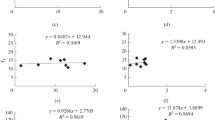Summary
The DNA content and size of individual nuclei from galls of perennial ryegrass root-tips induced byX. diversicaudatum andL. elongatus were measured. Feeding byX.diversicaudatum increased the DNA content of the nuclei by varying amounts. No regular doubling pattern of the DNA content was discernible. The DNA values varied up to between 32–64C. Generally the size of the nuclei was not increased, although some were larger than control nuclei. The modified nuclei probably have an altered metabolic function, which increases the food value of the gall to the nematode. Some bi-nucleate cells were also observed, which probably result from mitosis without cytokinesis. A preliminary examination of nuclei from galls induced byL. elongatus revealed similar nuclear changes, but no bi-nucleate cells were found.
Similar content being viewed by others
References
Barlow, P. W. (1977) An experimental study of cell and nuclear growth and their relation to cell division within a plant tissue.Differentiation 8, 153–7.
Bird, A. F. (1972) Quantitative studies on the growth of syncitia induced in plants by root knot nematodes.Int. J. Parasitol. 2, 157–70.
Brown, R. &Dyer, A. F. (1972) Cell division in higher plants. InPlant Physiology, Vol. V1C edited bySteward, A.), pp. 49–89 London, New York: Academic Press.
Callow, J. A. (1975) Endopolyploidy in maize smut neoplasms induced by the maize smut fungus,Ustilago maydis.New Phytol. 75, 253–7.
Cotten, J. (1977) Effect of annual and perennial cropping regimes in microplots on the population density and vertical distribution ofXiphinema diversicaudatum and on soil porosity.Ann. appl. Biol. 86, 397–404.
Deeley, E. M., Davies, H. G. &Chayen, J. (1957) The DNA content of cells in the root ofVicia faba.Expl Cell Res. 12, 582–91.
Flegg, J. J. M. (1967) Extraction ofXiphinema andLongidorus species from soil by a modification of Cobb's decanting and sieving technique.Ann. appl. Biol. 60, 429–37.
Fox, D. P. (1969) Some characteristics of the cold hydrolysis technique for staining plant tissues by the Feulgen reaction.J. Histochem. Cytochem. 17, 266–72.
Fox, D. P. (1970) DNA values in somatic tissues ofDermestes (Dermestidae: Coleoptera) 11. Malphigian tubules of the adult male.Chromosoma 31, 321–30.
Gilmour, R. S. &Paul, J. (1969) Organ specific restriction of transcription in mammalian chromatin.J. Molec. Biol. 40, 137–45.
Haskell, G. &Wills, A. B. (1968)Primer of Chromosome Practice. Edinburgh, London: Oliver and Boyd.
Hooper, D. J. (1973) Identification ofLongidorus andParalongidorus species found in the British Isles. InThe Longidoridae, Harpenden, England: Rothampsted Experimental Station.
Huang, R. C. &Bonner, J. (1962) Histone, a suppressor of chromosomal RNA synthesis.Proc. natn. Acad. Sci. U.S.A. 48, 1216–22.
Jones, M. G. K. (1980) Host cell responses to endoparasitic nematode attack: structure and function of giant cells and syncitia.Ann. appl. Biol. 97, 353–72.
Jordan, E. G., Timmis, T. N. &Trewavas, A. J. (1980) The plant nucleus. InThe Biochemistry of Plants, Vol. 1 (edited byTolbert, N. E.), London, New York: Academic Press.
Kurppa, S. &Robertson, W. M. (1979) Cell response to feeding byX. diversicaudatum andL. elongatus.Rep. Scott. hort. Res. Inst. 25, 119–20.
McElroy, F. D., Brown, D. J. F. &Boag, B. (1977) The virus-vector and damage potential, morphometrics and distribution ofParalongidorus maximus.J. Nematol. 9, 122–30.
Owens, R. G. &Rubinstein, J. H. (1966) Metabolic changes induced by root knot nematodes in host tissues.Contrib. Boyce Thompson Inst. Pl. Res. 23, 199–213.
Patau, K., Das, N. K. &Skoog, F. (1957) Induction of DNA synthesis by kinetin and indoleacetic acid in excised tobacco pith tissue.Physiologica Pl. 10, 949–66.
Rasch, E., Swift, H. &Klein, R. M. (1959) Nucleoprotein changes in plant tumour growth.J. biophys. biochem. Cytol. 6, 11–45.
Robertson, W. M. (1978) Ultrastructure of nematode vectors of plant viruses with special reference to their feeding apparatus.Rep. Scott. hort. Res. Inst. 24, 112.
Rumpenhorst, H. J. &Weischer, B. (1978) Histopathological and histochemical studies on grapevine roots damaged byXiphinema index.Rev. Nematol. 1, 217–25.
Southey, J. F. (1973) Identification ofXiphinema species. InThe Longidoridae. Harpenden, England: Rothampsted Experimental Station.
Taylor, C. E. (1967) The multiplication ofLongidorus elongatus (de Man) on different host plants with reference to virus transmission.Ann. appl. Biol. 59, 275–81.
Taylor, C. E. &Brown, D. J. F. (1974) An adaptable temperature controlled cabinet.Nematol. medit. 2, 171–5.
Thomas, P. R. (1969) Population development ofLongidorus elongatus in Scotland with observations onXiphinema diversicaudatum on raspberry.Nematologica 15, 582–90.
Thomas, P. R. (1970) Host status of some plants forXiphinema diversicaudatum (Micol.) and their susceptibility to viruses transmitted by this species.Ann. appl. Biol. 65, 169–78.
Thorne, G. (1939) A monograph of the nematodes of the superfamilyDorylaimoidea.Capita Zool. 8, 1–261.
Thorne, G. &Swanger, H. H. (1936) A monograph of the nematode generaDorylaimus dujardin Aporcelaimus N.G.,Dorylaimoides N.G. andPungentus N.G.Capita Zool. 6, 1–223.
Trudgill, D. L. (1977) Feeding behaviour ofXiphinema diversicaudatum.Rep. Scott. hort. Res. Inst. 23, 91–2.
Weischer, B. &Wyss, U. (1980) Development, histology and ultrastructure of root-tip galls induced by the ectoparasitic nematodeXiphinema index.Bull. Soc. bot. Fr. 127,Actual Bot., 67–69.
Wyss, U. (1975) Feeding ofTrichodorus, Longidorus andXiphinema. InNematode Vectors of Plant Viruses (edited byLamberti, F., Taylor, C. E. andSeinhorst, J. W.), pp. 203–221. New York: Plenum Press.
Wyss, U. (1977) Response of root cells to feeding byXiphinema index.J. Nematol. 9, 289.
Wyss, U., Lehmann, H. &Jank-Ludwig, R. (1980) Ultrastructure of modified root-tip cells inFicus carica, induced by the ectoparasitic nematodeXiphinema index.J. Cell Sci. 41, 193–208.
Author information
Authors and Affiliations
Rights and permissions
About this article
Cite this article
Griffiths, B.S., Robertson, W.M. & Trudgill, D.L. Nuclear changes induced by the nematodesXiphinema diversicaudatum andLongidorus elongatus in root-tips of perennial ryegrass,Lolium perenne . Histochem J 14, 719–730 (1982). https://doi.org/10.1007/BF01033621
Received:
Revised:
Issue Date:
DOI: https://doi.org/10.1007/BF01033621




